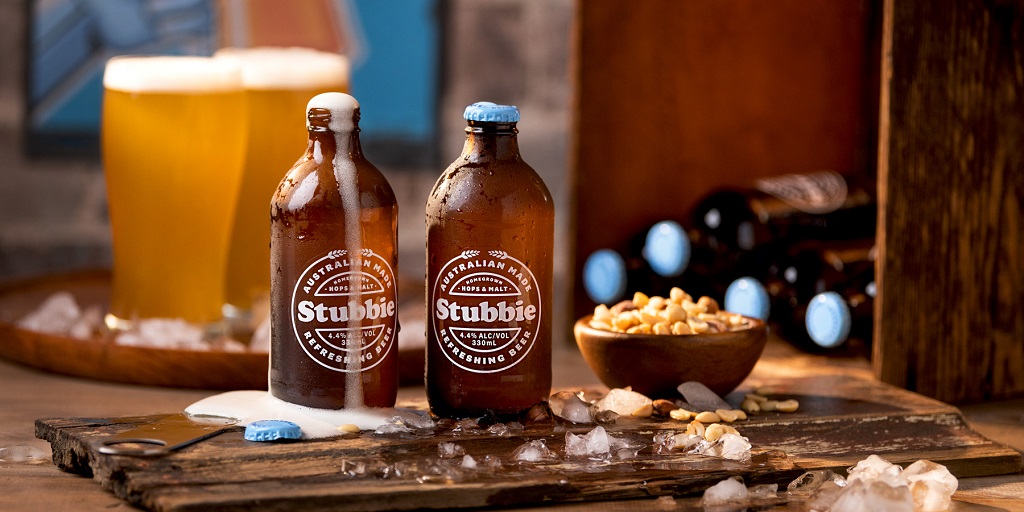
Nostalgia drives new retro beer

Pinnacle Drinks, owned by the Endeavour Drinks Group, has launched Stubbie, “a retro-style beer with a fresh new flavour”.
The Stubbies beer, a 4.4% abv Kolsch brewed at Good Drinks in WA, with ‘homegrown’ malt and hops, is packaged in an “old school” bottle, and is marketed as being “Just Like Your Dad’s beer – Only Better”.
“Retro” is a term that was first used in the 1970s to describe the move by designers to embrace historical styles, and the new beer by Pinnacle fits into the latest resurgence of retro trends.
As a marketing and design aspect it’s nothing new, but in a time when both craft beer brewers and retailers are looking at ways to differentiate their brands from others on the bottleshop shelves, it’s becoming an intriguing trend in beer.
Nostalgia has seen also a renaissance of genuine oldie favourites such as Reschs and Emu Export, to the point where Carlton & United Breweries has invested in the return of Reschs’ Silver Bullet cans.
But the adoption of retro trends and styles with new products is something that Stubbies, a private-label craft beer brand, has traded heavily on.
“Inspired by the days when shorts were short and mullets were long, new Stubbie Beer looks and tastes how an Australian beer should; smooth, balanced and stubbornly refreshing.
“It comes in an easy-to-grab stubbie bottle, designed with a nod to days gone by when having a yarn with a coldie over the back fence was fair dinkum at the end of a long hot day,” according to a media statement about Stubbies, which describes the beer as “quaffable without any waffle”.
Why go retro?
Professor Gary Mortimer at QUT Business School specialises in marketing, advertising and public relations, and told Brews News that the concept of tapping into nostalgic connections when it comes to behaviours is an interesting one.
“Nostalgia, derived from two Greek roots: “nostos” meaning to “return home ” and “algos” referring to “pain or grief”, signals an emotion contains both pleasant and unpleasant components.
“This “bittersweet” quality of the emotion is a distinguishing characteristic of the nostalgic condition.
“Nostalgia refers to an earlier period of one’s life, which may evoke memories of peaceful, pleasant times or of times of tension and turmoil.”
But marketing by tapping into people’s feelings of nostalgia is a 20th-century phenomenon.
“Nostalgia has become a commodity that can be bought and sold. Nostalgia marketing emerged from the 1970’s, and relates to the creation of a brand identity based on heritage or nostalgia for a company’s past products or brands.”
He said that this nostalgia marketing was driving a resurgence to classic and retro brands and products, which has fed into the revival of everything from vinyl records and board games to the famous 1980s Atari console and Polaroid cameras.
“They are all modern versions, with a respectful nod to the past.”
When it comes to new products, this nod to the past can in fact attract new customers, who may be standard mainstream lager drinkers, but who would be willing to try a new brand which resembled something from their past.
“The benefits are that products, packaging and brands that reflect a past important period of someone’s life, are more likely going to connect with that person,” explained Professor Mortimer.
“So, if your target market is male beer drinkers, aged 40-60 years, then their first consumption experiences (and memories) of beer would be from the late 70’s and 80’s.
“Packaging that reflected the products of that time would connect with that audience and the consumer is more likely to purchase.
“The only risks of ‘retro’ is that younger audiences don’t experience the ‘nostalgia’ connected with the product, so aren’t necessarily motivated to buy, Mortimer explained.
He said it was also about marketing trends which have developed around the ability to tell a good story.
“It is very much about storytelling. Sitting around with a few friends reflecting on past events, while engaging with the product – be it a classic vinyl record or a ‘stubbie’.”



